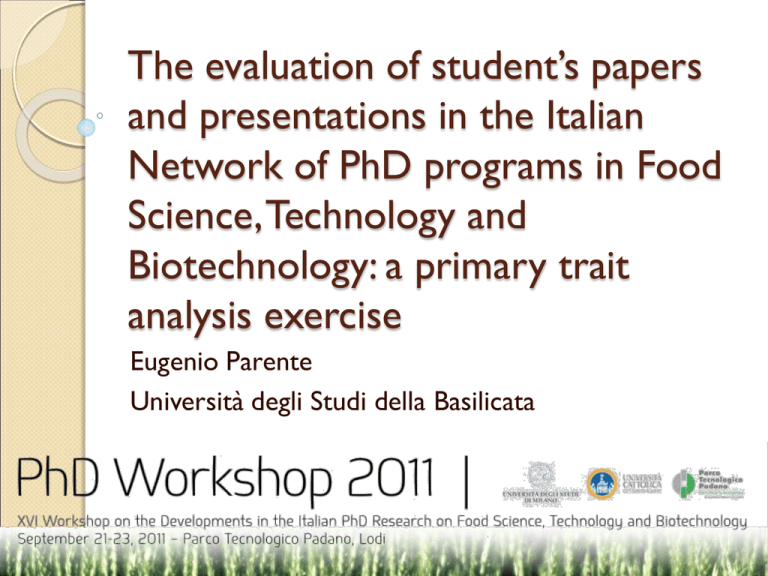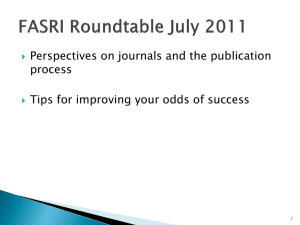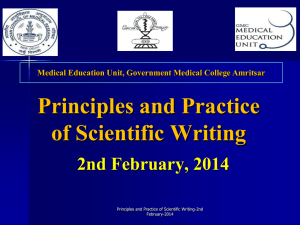Diapositiva 1
advertisement

The evaluation of student’s papers and presentations in the Italian Network of PhD programs in Food Science, Technology and Biotechnology: a primary trait analysis exercise Eugenio Parente Università degli Studi della Basilicata In this presentation the need for a consensus system for PhD student evaluation a word on plagiarism what is primary trait analysis? the “ideal” paper and presentation the rubric: ◦ Material organization, accuracy, language, discussion of results, references ◦ Research and methodology, novelty, statistical analysis, data-supported conclusions ◦ Quality of the presentation, clarity, language property, mastery of the topic ◦ Interaction with the referees An overview of the evaluation at the XV Workshop The Network of Italian PhD programs in Food Science, Technology and Biotechnology Estabilished in 1995 Currently includes 24 PhD programs (Doctorate Schools, Doctorate courses, curricula) promotes an annual meeting promotes students exchanges, co-operation among PhD courses, fosters excellence in scientific achievements in Food Science, Technology and Biotechnology The workshop first workshop in Viterbo, now in the XVI edition at the PTP Lodi attendance has increased over time:122 students attended the XV Workshop in Naples designed to encourage exchage of ideas and experiences among students, tutors and coordinators intended to train students in presenting and defending their work ◦ first year students: PhD Dissertation project and miniposter ◦ second year students: short communication and poster ◦ third year students: short paper and oral communication students are evaluated on a pentenary scale and ECTS credits are assigned as a result of the evaluation the Proceedings are published as hard copy and on DVD-ROM The evaluation process the students are required to submit a paper within the end of June the responsibility of ensuring the quality of the paper and the compliance with the presentation guidelines remains with the student, the tutor and the PhD coordinator papers are published as they are in the Proceedings at the workshop: ◦ first and second year students present a poster, which must be discussed with 2 reviewers, who grade the work ◦ third year students are required to give an oral presentation and to discuss it with the session chairman and/or additional reviewers The reviewers turn in the evaluation sheets to the Organizing Committee, and a certificate is issued to the students The need for a consensus system students and reviewers come from different areas (Food Science, Food Microbiology, Food Chemistry, etc.) in which different standards may be applied there is a need to: ◦ make the process transparent (i.e. the students must be informed of what is expected of them) ◦ make the process fair (i.e. the referees should use a similar evaluation scale) The process in use has evolved in several years of discussions and debate A word on plagiarism plagiarism is a plague in science (and teaching) and students do not seem to be fully aware of the consequences plagiarism is "taking over the ideas, methods, or written words of another, without acknowledgment and with the intention that they be taken as the work of the deceiver." American Association of University Professors (September/October, 1989). ethical writing principles are necessary students must be aware that republishing material published elsewhere is something to be avoided The design of the evaluation score sheet: a primary trait analysis exercise “Primary Trait Analysis (PTA) is a way to take what we already do - record grades - and translate that process into an assessment device”. B. Walvoord and L.P. McCarthy, 1990 the PTA procedure (barebones): ◦ ◦ ◦ ◦ ◦ ◦ learning goals are clearly identified a test/assignment is designed to evaluate how the learning goals have been achieved the assignment (the paper, poster, presentation) is split in components (the primary traits) a rubric (in the form of a table or a list) is built to identify different levels of achievement of the learning goals and a score is assigned to each level each cell should contain an “anchor”: a verbal description of the level of performance corresponding to the cell. As a result, different reviewers should assign approximately similar grades to similar performances the rubric is made public in advance if correctly carried out the PTA procedure has several advantages ◦ ◦ ◦ ◦ it is clear it is transparent it is fair it assists both the teacher and the student in assessing how well the learning goals have been achieved The rubric Manuscript quality: MQ, 30 points. Material organization, accuracy, language, discussion of results, references Novelty of contents: NC, 20 points, research and methodology, novelty, statistical analysis, datasupported conclusions Presentation quality: PQ, 20 points. quality of the presentation, clarity, language property, mastery of the topic Interaction with the referee: AR, 30 points, Accurate reply to referee's questions The rubric The rubric The “ideal manuscript”: manuscript quality material organization (tests the ability of the student to write a scientific paper in the format required by a given journal): ◦ the text must be drafted in accordance to the guidelines for authors; ◦ all the required sections are included; ◦ the objectives are clearly stated; ◦ all figures and tables arereferred to in the text and provided with clear legends/headings, ◦ the presentation of results is clear and concise; ◦ the reference list was drafted according to the instructions The “ideal manuscript”: manuscript quality Accuracy (evaluates the ability to present materials and methods, figures and tables): ◦ the material and methods must be clearly illustrated, ◦ the results section must be complete, ◦ Tables and Figures must show the results with the necessary accuracy (significant digits, readability). Language (evalutes the ability to use sceintific English): ◦ the text must be correct in terms of spelling, grammar, English usage. The “ideal manuscript”: manuscript quality Discussion of results (evalutes the ability to discuss rather than merely present, the results): ◦ the results must be discussed in view of the objectives and of current literature and not merely described; ◦ the authors must present data supported hypotheses; the speculation must be avoided in the discussion. References (evaluates the ability to select and use an adequate set of references): ◦ the references must be sufficient to illustrate the state of art (as related to the subject of the article) ◦ must be sufficient to correctly used to discuss any correspondence or disagreement with the author's findings. The “ideal manuscript”: novelty of contents Research methodology (evaluates the ability to use an appropriate methodological approach): ◦ the research methodology described in the text published in the Book of Proceedings should be appropriate for the topic at hand (given the resources available); Novelty (evaluates the ability to address new ideas/subject/approaches): ◦ the work must be novel in terms of approach, methodology, results, conclusions ◦ plagiarism (including self-plagiarism) is unacceptable The “ideal manuscript”: novelty of contents Statistical analysis (evaluates he ability to design experiments and analyze the data with the appropriate method): (not applicable to miniposters) ◦ the statistical methods must be appropriate for the topic at hand ◦ the results of the analysis must be clearly presented, without redundancy and unnecessary details. ◦ there is no excuse for lack of statistical treatment of the data. Data supported conclusions (evaluates the ability to critically analyze the results): (not applicable to miniposters) ◦ the conclusions must be fully supported by the data and any discrepancy with the objective, hypotheses, literature has to be addressed and/or explained. The “ideal presentation”: presentation quality Quality of the presentation (evaluates the ability to set up and organize an oral or poster presentation): ◦ the oral, poster or miniposter communication must be clearly organized (sequence, graphics, organization) ◦ must not exceed the allotted time (15 min for the oral communication or 5 min for the poster and miniposter) ◦ must be clearly readable/visible by the audience. Clarity (evaluates the content of the presentation/poster): ◦ the introductory material, the methods and the results must be clearly presented, ◦ the results must be discussed and compared with the literature and with the objective of the work The “ideal presentation”: presentation quality Mastery of the topic (evaluates the knowledge of the problem at hand): ◦ the author (not the tutor) must be current with the pertinent scientific literature, master the methods and understand the results and their implications. Language usage (tests fluency in spoken English): ◦ the spoken language must be correct in terms of grammar, English usage, and pronunciation. If the presentation is in Italian the score is automatically nil. The “ideal presentation”: interaction with the referees we espect that our students are able to defend successfully their work in a scientific meeting ◦ their answers must be pertinent and complete ◦ if the referees points out a problem (maliciously or not) that problem must be addressed in a satisfactory way, not eluded The evaluation as an assessment exercise the purpose of a PTA excercise is two-fold: ◦ grading i.e. assigning a grade (A to E) in a fair and transparent way ◦ assessment: i.e. evaluating the teaching, learning, and assessment process itself to introduce corrections is needed Standardized score A bit of stats: the evaluation at the XV workshop. Q1. Do the students improve over time? Data for 3° year students A bit of stats: the evaluation at the XV workshop. Q2. Is the distribution of scores normal? Standardized total score A bit of stats: the evaluation at the XV workshop. Q3. Is there any difference among students from different PhD courses? A bit of stats: the evaluation at the XV workshop. Q4. Can we build a synthetic index (using PCA) and compare students (raw scores are used)? total score PQ, AR circles: 1st year triangles: 2nd year squares: 3° year MQ, NC What now?







